Last edit: 05-03-17 Graham Wideman
| Last edit: 05-03-17 Graham Wideman |
Intelligence and Change in Enterprises |
| Evolution of the Human Relationship to Knowledge Article created: 99-05-01 |
[Pretty drafty]
This page attempts to set our current state of knowledge sophistication in the context of the major series of cognitive and cultural stages that have occurred in the past, and are forecast to occur in the future.
For a view of the past stages, Merlin Donald's Origins
of the Modern Mind is very thoughtful. I have based much of the following on his
construction, but have extended it somewhat by adding futurists' thinking about upcoming
stages.
(Note: I have not attempted to place the cognitive skills in particular
areas of the brain -- it's just an icon, and it's obviously not the correct brain for the
early eras!)
Model of Thinking
Organism
|
Era, Discussion |
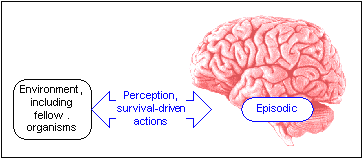 |
Primate The primate is considered to have only just enough cognitive power to sense what is going on in the environment, and respond to it "episode by episode". There is of course some learning, and some communication between peers, but little or no abstract ability. With minimal ability to communicate, there is only limited ability to achieve "knowledge" beyond what an individual can experience directly in a life time. |
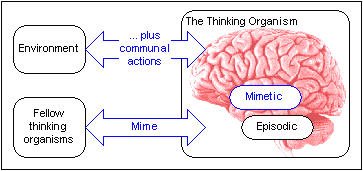 |
1,500,000 -
200,000 BCE? Homo Erectus, Miming capabilty Donald argues that a key "hardware" advance occurs with homo erectus -- the ability to communicate by mime. Gesture or acting provides a rudimentary way to refer to things or events that are not immediately present -- perhaps to coordinate action, indicate the location and nature of food or danger. Though mime provides only a very laborious and imprecise medium for communication, individuals would have been able to gain at least some knowledge from their contemporaries beyond what they can develop through direct experience. |
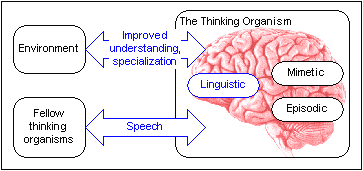 |
100,000 BCE
Archaic Human Speech The subject of how or why language developed, and whether it was a primarily hardware or cultural advance, is hotly debated. However, given the capability, the individual's and society's knowledge horizons expand considerably. Now the individual can learn not just from direct contact with other individuals and groups, but also from narratives brought orally from afar. The use of language depends on an advance in conceptual abilities, and also provides a medium for promoting such advances. So doubtless early going was slow as conceptual abilities and the richness of the speech medium slowly racheted up over generations. Eventually speech could carry knowledge (if with limited reliability) from far places and times. Donald elaborates the intimate connection between spoken language and "mythic" cultures -- which develop and store crucial knowledge in myths, preserved by an oral tradition. |
 |
40,000-20,000
BCE Cave paintings, Cave paintings and representational carvings form the beginnings of "external long-term storage" of information. External storage has several qualities of interest.
It is not clear how much thinking skills were helped by early drawing, or how much knowledge was conveyed. Communicating via pictures is potentially powerful, but would have been laborious with early materials, and not very portable. However, it seems likely that early drawing, combined with the communications abilities refined through use of speech, must have played a role in the development of early pictorial written languages. |
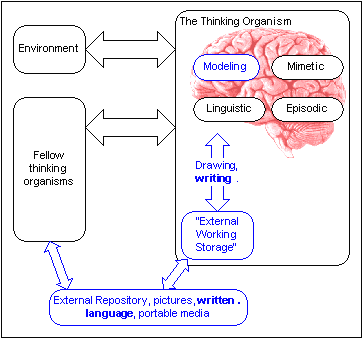 |
4000 BCE - 1400
CE Development of writing The development of systems of written symbols for concrete and abstract ideas finally provides a way to vastly increase the possibility for individuals to draw from and contribute to a stream of knowledge from near and far, contemporary or from the past. In addition, writing (and the accompanying "technological" materials) provides a crucial adjunct to a brain that's short on capacity to think or communicate about many complex ideas at once. Hence writing provides a crucial hardware assist to the thinking organism, a vast increase in the data available for the organism to consider, and a greatly improved capacity for individual thinking organisms to think together. The drawing shows that Thinking Organisms now routinely used external storage to think with. During this period large areas of science and philosophy were widely and productively explored, facilitated largely by the ability to think, store and communicate via writing. Some advances, such as in mathematics could be attributed almost entirely to "playing with written symbols". The mustering of the efforts of increasingly large numbers of people by advances in administration-at-a-distance was made possible largely by writing. However, access to written works (or the education to read them) was limited by the fact that copies had to be created manually, and control of access often lay in the hands of ruling or religious elites. |
 |
Era of broadcast
media and mass production. 1450: Printing introduced 1750-???: Industrial revolution 1800: Steam-powered press 1930: Widespread radio 1955-60: Widespread TV The industrial revolution powered the printing press, and the printing press provided the means for broadly disseminating knowledge, literacy, administrative control and so forth. Not much of a leap in achievable cognitive power for the elite, but a much wider access to cognitive development for the non-elite, and an explosion in the availability and exchange of information and ideas. Meanwhile the Industrial Revolution fueled and was fuelded by a surge in explorations of all kinds, thereby adding rapidly to the knowledge base. |
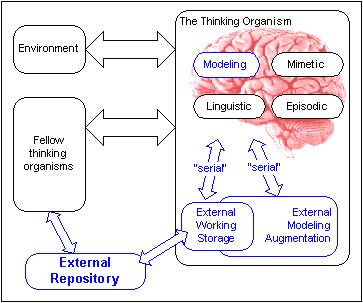 |
1980-1990 CE: Widespread introduction of personal computers and workstations. Now for the first time there is widespread ability for the Thinking Organism to use not just external scratchpad storage, but also external processing power. The expanded external storage of data , and automation of repetitive tasks on that data were of course much valued. However it was the modeling capability that most advanced cognitive power, enabling thoughts to be thought that were formerly impossible.These included models of all manner of systems from atomic to interplanetary scale, from esoteric scientific subject areas to everyday business processes and decision making and military uses. These in turn have led to an extraordinary jump in the rate of scientific discovery, product development and so on, including of course advancing the state of computer systems and software.... So the personal computer of this era presents two hardware advances -- one a huge quantitative advance in the ability to process data in mundane ways, the other a leap in the ability of the thinking organism (including the PC) to execute a model. On the other hand, during the 1980-90 era, two glaring bottlenecks were evident: Much of an individual's interaction with external storage was disconnected from the helpful augmentation of computing power, and interaction between brain, external storage and external modeling were both through low-bandwidth "serial" channels -- sequences of text or numbers. |
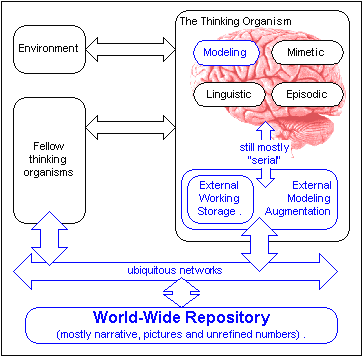 |
1994-1999 CE:
The Web takes off World Wide The web -- blah blah blah -- obviously a huge increase in circulation of information (along with noise). With perhaps only incremental, already-possible improvements, the combination of a local computer plus good software plus the web seems like it might eventually unify our increased brain-plus-computer cognitive power with the access to vast amounts of information. Even if that were achieved, at that point the most evident limitations would still be between brain and the local computer's storage and modeling capability -- "still mostly serial" -- though at least more graphical than in the 80's. Meanwhile, computers plus the web have ushered in the e-business era, in which the pace of business and societal change has dramatically increased. This has led to widespread need for many more people to be making many more significant decisions more rapidly. Each decision involves increasingly many interdependencies, and an overload of information available, but the Thinking Organism's cognitive ability (even under the improved scenario above) is still underpowered to convert this information into useful models for decisions. |
We Are Here |
|
1999-2005: Web Ubiquitous, Overload Evident, Focus on Models
In essence the problem may be stated as a shortcoming in the ability for the individual to acquire or develop sufficiently sophisticated models of a situation sufficiently rapidly. So it follows that a potential answer lies in improving that ability. This would entail developing a modeling vocabulary and environment that affords several needed characteristics:
|
|
The Far (?) Future |
|
| There seems to be some agreement amongst futurists that one or both of the following scenarios will come about. There is much disagreement as to when, though it seems popular to assert that it could be as early as 2030. It seems out of fashion to suggest that it's "at least a thousand years away". One interesting thread to visit on this topic is Vernor Vinge's "The Coming Technological Singularity" which is much critiqued on the web (see any search engine). If these possibilities seem extraordinary, it as well to remember that there is a long tradition of technological changes looking a lot less whacky after they happened than before! | |
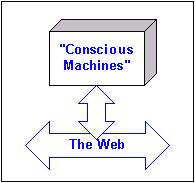 |
Machine
Intelligence Achieves Parity with Humans This line of thinking sees it as only a matter of time before computers are as smart as humans. If you don't buy the idea that current hardware and software technology simply made faster and bigger can do it, then nanotechnology enthusiasts suggest we'll just build a thing that looks like a brain. At any rate, there is then a notion that if we can bootstrap our way to building a human-mind-equivalent, then shortly thereafter we or they will be able to build super-intelligent machines, etc etc. What happens then? Do they go on without us? |
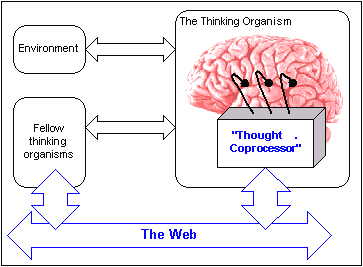 |
Human
Intelligence is Artificially Augmented Advances in neurosurgical technology are seen as, at some point, capable of providing a direct brain-to-computer connection, finally removing the constraints of gestural or speech channels (from human to computer) and visual/aural channels (computer to human). This is imagined to vastly increase the capability to interact with external models and information, and also with other people, because it removes the necessity to serialize information through the sensory and motor channels. There are ideas of directly "uploading" and "downloading" ideas or mental states. Similar to the "conscious machines"scenario, shortly after "though coprocessors" are feasible, it's expected that humans so augmented will rapidly design ever more advanced versions. |